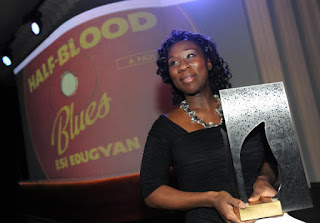“For weeks the kid been going on and on about how dreadful we sound. He kept snatching up the discs, scratching the lacquer with a pocket knife, wrecking them. Yelling how there wasn’t nothing there. But there was something. Some seed of twisted beauty.”
Ever since childhood, my favourite thing about the Christmas holidays has been the lazy, languid days of curling up in my bathrobe and doing nothing but reading all day. And this year has been no exception. Right now, as I write, I’m wearing my favourite black terry cloth robe, a stack of books teetering on the sofa beside me.
Not surprisingly, I got a lot of gift certificates for bookstores for Christmas. The first book I bought was Esi Edugyan’s Giller-winning Half-Blood Blues. I read this novel in just a couple days, unable to put it down. What a pleasure to become immersed in the strange, delicious world of this novel, the underground jazz scene of Berlin and Paris during the Second World War, as seen through the eyes of Sid Griffiths, a “half-blood” musician from Baltimore, whose skin is so light he can almost pass for white. But just the opposite is true for others in the band, most notably Hieronymus Falk, who, despite being the youngest, is the genius of the group. Hieronymus – “Hiero,” as he’s known – is a “Rhineland bastard.” He’s of mixed German and African parentage, fathered by a Senegalese soldier who was serving as part of the French colonial troops occupying the Rhineland after World War One. Despite growing up being reviled for his skin and relegated to a stateless identity, Hiero has musical talents that win him the name “Little Louis.” Sid and the others take him under their wing, as a little brother at first, but as Hiero develops as a musician and artist, his remarkable abilities lead to tensions and rivalry. Particularly where a certain singer, Delilah Brown, is concerned. Sid becomes enamoured from the moment he first glimpses her strangely glamorous turban and thin, stark body and mesmerizing, pale green eyes. Although she returns his affections, to an extent, she appears far more enticed by Hiero’s musical brilliance.
This is what I found so compelling about this novel: Edugyan brings to life a slice of history that until now, I’d known very little about, yet she does so through the lens of a set of characters and relationships that are so rich they’re constantly drawing me in. Who among us can’t relate to the predicament of being jealous of a more talented friend? Yet what under normal circumstances would simply be clashing egos and rivalries over art and women lead to much larger, tragic events in Nazi-occupied Germany. Sid’s guilt and tormented conscience over whether he could have done something to prevent Hiero’s capture by Nazi police, in the riveting opening scene, lays the ground for his emotional journey in the rest of the novel.
Photo from: here




